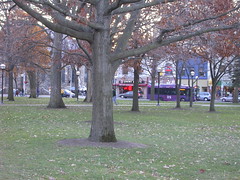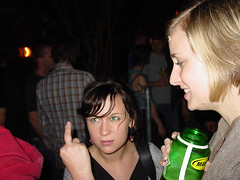Mixing uses and mixing demographics, can't we all just get along? Maybe not.
The great thing about the suburbs is supposed to be open space and places to play. The Washington Post reports, in "Bill to Quiet Ballfields Creates an Uproar: Va. Youth Leagues Quickly Mobilize Against Constraints on Playing Hours" that "neighbors living next to busy athletic fields [want] some peace and quiet."
But the question of balancing uses is a big one. How do you balance very neighborhood-centric concerns vs. community-wide concerns and issues, managing use, but at the same time ensuring fairness.?
OTOH, it's like the people who complain (justifiably) about the noise from living in the flight path to National Airport. I understand the complaint, but they chose to live there, and the "noxious use" is pre-existing.
2. Speaking of noxious uses and how mixing different age demographics can be problematic, my sense is that college students, at least in Florida, are more in the phase of their lives where "multiplistic thinking" (all behaviors have equal weight, one can't judge others choices) is dominant rather than the stage that William Perry called "Commitment in Relativism," where "Student(s) see the necessity of: - making choices - committing to a solution and integration of knowledge learned from others with personal experience and reflection."
 Student ghetto in Ann Arbor, Michigan, of which I have fond memories. Photo from Sanda Kaufman.
Student ghetto in Ann Arbor, Michigan, of which I have fond memories. Photo from Sanda Kaufman.E.g., Once I had an idea that a dorm-life-long learning development be constructed at the Brookland Metro site, in conjunction with Catholic University and/or Trinity University, as the latter institution has a very active elderhostel program. My mentor pointed out to me the experience of older residents in apartment buildings in Foggy Bottom, where many buildings have been bought up by GWU, which then houses students there--older residents don't particularly enjoy sharing elevators with vomiting undergraduates.
The student newspaper at the University of Florida in Gainesville has this to say about these issues, in the editorial "Rude welcome: Residents bemoan student neighbors":
Some Gainesville residents are throwing a fit over their student neighbors. At a joint Public Safety Committee and Community Development Committee meeting on Thursday, many aired their complaints. "They are becoming active at the time I go to bed," said Mary Anne Gularte. She added that she now has to sleep in "a series of naps." Many at the meeting proposed simply enforcing the existing city ordinances to help bring the students back in line. They should have stopped to examine whether the ordinances should be enforced in the first place...
We don't think either of those issues is the city's business. If students want to drive all over their front lawns and have 10 people living in one house, well, that's their decision. The government and busybody residents need to recognize when to butt out. ...
But we have to ask why this city is inherently unfriendly to students, especially when the university's growth could be a godsend for urban revitalization.
________
I think the answer to their question is already present earlier in the editorial. Nobody, students or not, wants to live by neighbors who have absolutely no concern about how their actions negatively impact others.
And this does make me question, somewhat my frequent entreaties about the need to harvest more university-based resources for neighborhood revitalization, especially after seeing a great presentation last week from Tom Foegler of the Ohio State University Campus Partners program in the High Street community adjacent to the campus.
 State Street at East William, near East University, Ann Arbor, Michigan. View of retail stores from the grounds of the University of Michigan. Photo from Sanda Kaufman.
State Street at East William, near East University, Ann Arbor, Michigan. View of retail stores from the grounds of the University of Michigan. Photo from Sanda Kaufman.Even when I wasn't a student at the University of Michigan, I enjoyed living in more student ghetto-type areas, and partaking of the easy access to university-based resources, and the variety of retail amenities that were supported in part by the large student population, from great bookstores (the Borders chain grew from its original store in Ann Arbor, where I shopped long before there was ever a second Borders store) to coffee shops and restaurants.
 Flickr photo tagged "Gainesville" by CodyWyoming.
Flickr photo tagged "Gainesville" by CodyWyoming.However, I'm not sure I'd want to live across the street from the editors of the Alligator newspaper. Still and all, this Post travel piece makes it sound nice "In Gainesville, Fla., No Swamp Thing" (I haven't been to Gainesville for over 10 years...)
Also see "FRATERNITY ROW, THE STUDENT GHETTO, AND THE FACULTY ENCLAVE: Characteristic Residential Districts in the American College Town" by Blake Gumprecht of the University of New Hampshire.
Index Keywords: civility



0 Comments:
Post a Comment
<< Home